#CelineAndPassagesInParis
Explore tagged Tumblr posts
Text




.
Wednesday Wanderings and Wonderings - The Passage Edition
Passage Verdeau (6, rue de la Grange Batelière – 31, bis rue du Faubourg Montmartre, 75009 Paris)
Opened in 1846 by the Société du Passage Jouffroy, it was named after one of the members of this society, Mr. Verdeau, who "invented" the renting of linen for hotels, restaurants or other receptions. In the continuation of the Jouffroy and Panoramas passages, it is one of the clearest and most airy passages, with its high fishbone glass roof and a very pure design of neo-classical lines.
Since the opening of the Hôtel Drouot, the Passage has attracted many collectors. In addition to old books, one finds in this passage, second-hand cameras, old furniture, embroideries. There are also several restaurants and tea rooms. (Source)
*** But what is a passage? It is a private road open to the public, a shortcut between several roads, whether covered or not. As a pedestrian space, the passage can house both commerce and housing. Only the abundant decoration and the luxury of the stores differentiate a gallery from a passage. It’s the ancestor of today's shopping malls, the unique charm of Parisian covered passages will immediately transport you to the 19th century (Previous Posts)***
#CelineIsNotAnExpatAnymore#France life#Paris#passages#CelineAndPassagesInParis#CelineWandersAndWondersInParis
7 notes
·
View notes
Text
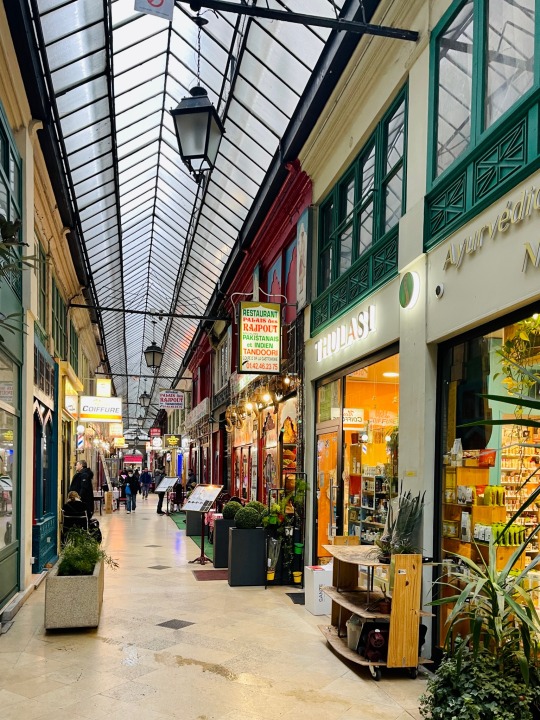


.
Wednesday Wanderings and Wonderings - The Passage Edition
Passage Brady (43, rue du Faubourg-Saint-Martin - 46, rue du Faubourg-Saint-Denis 75010 Paris)
Not quite the same type of passages found in the 2nd and 9th district, Passage Brady is often referred as “Little India". Since 1973 you will find the largest choice of Indian products in Paris at the supermarket Bazar Velan, an institution. In the 90s it had a bad reputation but
In the early 1820s, Mr. Brady, a merchant living in the faubourg Saint Denis, formed an ambitious project for a covered passageway, the longest in Paris. He imagined a real little village made up of one hundred and thirteen stores with lodgings on the floor. Brady joined forces with M. Briavoine, a merchant, and work began in 1825. The shopping mall was to extend from the rue du Faubourg Saint Denis to the rue du Faubourg Saint Martin. During the course of the work, the promoters decided not to cover the entire passage. The covered western section and the open eastern section were not perfectly aligned and the irregularity of the layout was compensated for by the construction of a rotunda at the point of deviation, which marked the junction between the two sections.
The Brady Passage was inaugurated on April 15, 1828. At the beginning, there were reading rooms, elegant stores and even a bathhouse. But the passage struggled to find its clientele. Very quickly out of fashion, victim of commercial failures, the situation deteriorated. As early as 1834, classic clothing and leather goods gave way to thrift shops and dubious stalls. In 1852, the Brady passage fell victim to the great Haussmannian works. The piercing of the boulevard de Strasbourg, which extended the boulevard Sébastopol, cut it off from its central part and made the rotunda disappear. The covered gallery is definitively removed from the open-air portion and develops into an autonomous alley.
In the early 90s, dubious hotels have opened their doors and sleep merchants have housed entire families in precarious conditions. In November 2007, a major fire broke out in degraded housing and five people died. Following this terrible accident, controls were reinforced. As early as 2009, funds are gathered to consider a thorough renovation. The phase of work begins in 2013. Since March 2002 The passage Brady is classified as a Historic Monument.
** But what is a passage? It is a private road open to the public, a shortcut between several roads, whether covered or not. As a pedestrian space, the passage can house both commerce and housing. Only the abundant decoration and the luxury of the stores differentiate a gallery from a passage. It’s the ancestor of today's shopping malls, the unique charm of Parisian covered passages will immediately transport you to the 19th century (Previous Posts)***
#CelineIsNotAnExpatAnymore#France life#Paris#CelineWandersAndWondersInParis#CelineAndPassagesInParis
3 notes
·
View notes
Text
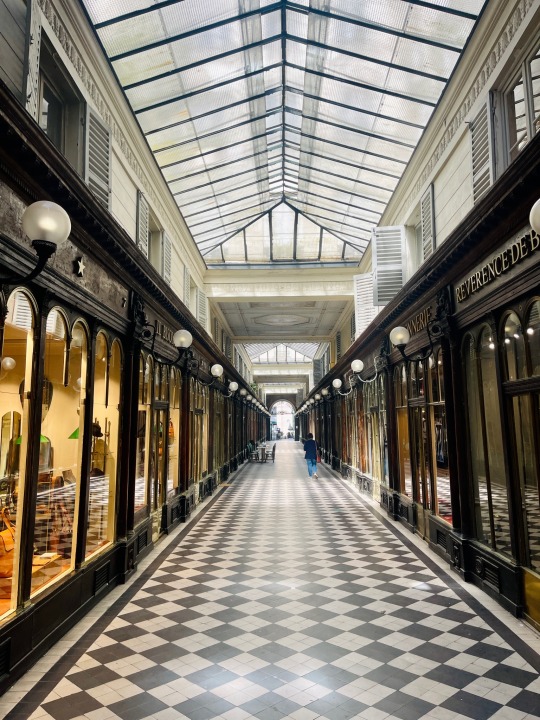
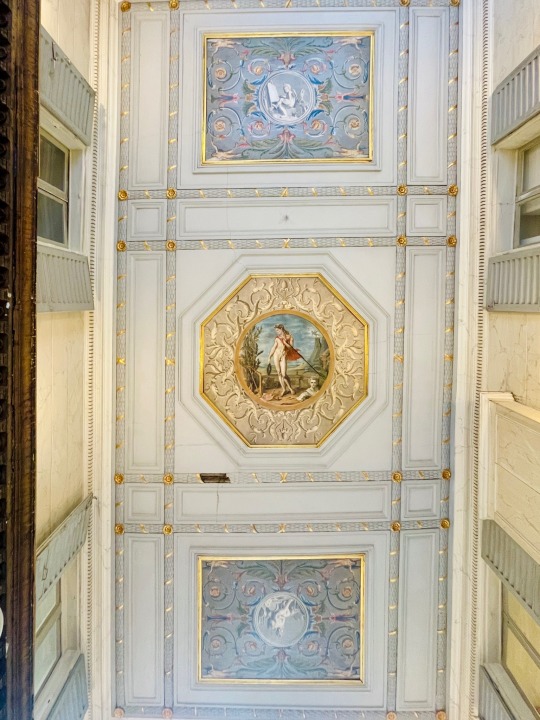

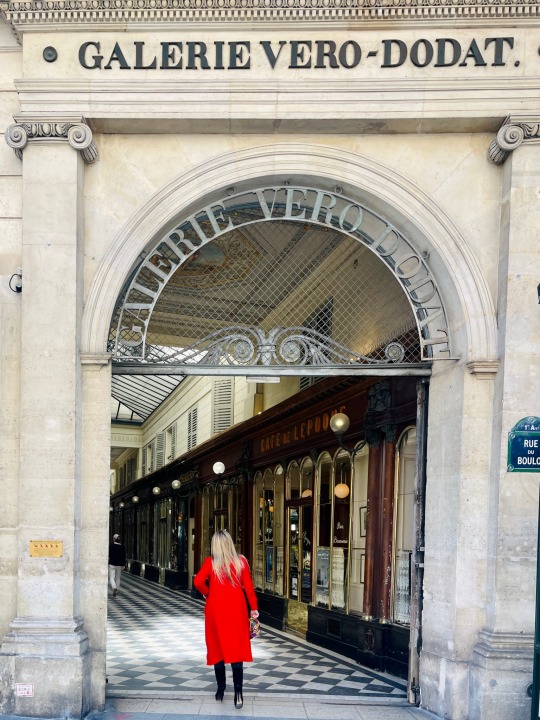
.
Wednesday Wanderings and Wonderings - The Passage Edition
Passage Vero-Dodat (19, rue Jean-Jacques Rousseau – 2, rue du Bouloi, 75001 Paris)
1826, two investors, the Charcutier Véro and l Dodat, decided to build a gallery between the streets of Bouloi and Jean-Jacques Rousseau. They built a neo-classical gallery with copper and cast iron ornaments, mirrors, paintings, columns, and a floor paved with black and white marble and globes of light. The Galerie Véro-Dodat owes its success to the store of the "Messageries Laffitte et Gaillard", located in front of the entrance, on Jean-Jacques Rousseau street. While waiting for their stagecoaches, travelers would stroll among the fashionable stores.
The Second Empire and the disappearance of the "Messageries" marked the decline of the gallery. Even if the gallery's appeal diminished, it continues to offer the visitor an image of the Belle Époque. It was remarkably restored in 1997. One can admire the splendidly restored coffered ceilings and the richness of the decorations. It contains art galleries, fashion boutiques, a famous violin maker and a "period" brasserie. (source)
*** But what is a passage? It is a private road open to the public, a shortcut between several roads, whether covered or not. As a pedestrian space, the passage can house both commerce and housing. Only the abundant decoration and the luxury of the stores differentiate a gallery from a passage. It’s the ancestor of today's shopping malls, the unique charm of Parisian covered passages will immediately transport you to the 19th century (Previous Posts)***
#CelineIsNotAnExpatAnymore#France life#Paris#passages#CelineWandersAndWondersInParis#CelineAndPassagesInParis
2 notes
·
View notes
Text


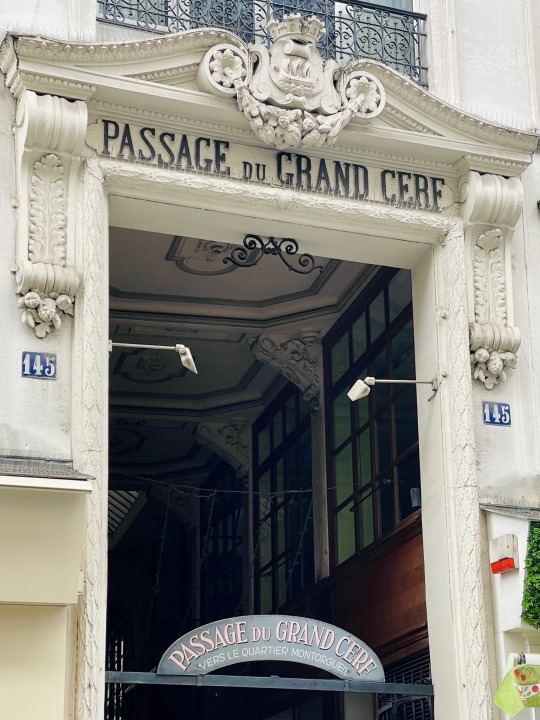
.
Wednesday Wanderings and Wonderings - The Passage Edition
Passage du Grand Cerf (145, rue Saint-Denis – 10 rue Dussoubs, 75002 Paris).
-> The highest (11.80 m) of all the Parisian passages
In 1825, the house of the "roulage du Grand Cerf", which was the terminus of the Messageries Royales, was demolished. Around 1835, the passage was opened. The style of the glass roof is however later. Its history is closely linked to the history of the district: in 1830, the Saint-Denis district was the most popular and industrious in Paris, with small factories and workshops. The appearance of more luxurious passages overshadowed the Passage du Grand Cerf. Nevertheless, the quality of its architecture deserves attention. Its height, 11.80 m, is the highest of all the Parisian passages.
Its partly metallic structure allowed for two levels of entirely glazed façade. The living quarters only start from the third floor. Thus, it could be said that this Passage was rather intended for production and craftsmanship than for luxury and the sale of its products. Neglected for many years, the Passage du Grand Cerf was rehabilitated in 1990. It is now one of the most attractive passages in Paris. It gathers jewelry and fashion designers, gallery owners and decoration stores. (Source)
*** But what is a passage? It is a private road open to the public, a shortcut between several roads, whether covered or not. As a pedestrian space, the passage can house both commerce and housing. Only the abundant decoration and the luxury of the stores differentiate a gallery from a passage. It’s the ancestor of today's shopping malls, the unique charm of Parisian covered passages will immediately transport you to the 19th century (Previous Posts)***
#CelineIsNotAnExpatAnymore#France life#Paris#passages#CelineWandersAndWondersInParis#CelineAndPassagesInParis
2 notes
·
View notes
Text


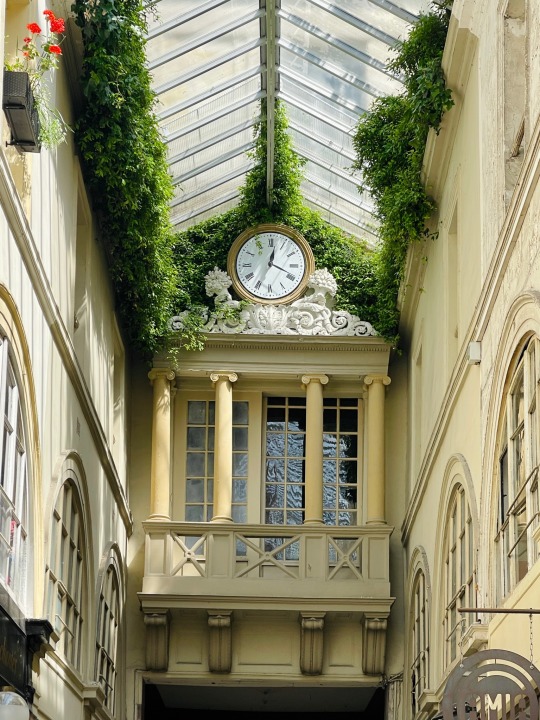


.
Wednesday Wanderings and Wonderings - The Passage Edition
Passage Choiseul (40, rue des Petits Champs – 23, rue Saint Augustin, 75002 Paris)
-> The longest passageway with 190 meters long
The passage was built around 1825 by the architect TAVERNIER on the site of 4 hotels. Only a few elements of the Hôtel de Gesvres were preserved, including the porch that today forms the north entrance. The main passageway is 190 meters long, one of the longest in Paris. According to Geist, "it is of all the Parisian passages that best embodies the character of a street", two rows of houses are opposite each other, connected only by a detached glass roof.
The theater and literature were the two most prominent aspects of the passage. In the large alley, the regulars of the surrounding theaters strolled. Since its origin, the life of the passage is linked to that of two theaters, the Opéra Comique, housed in the Salle Ventadour, which now belongs to the Banque de France, and the Bouffes Parisiens, Jacques Offenbach's theater, which belongs to his descendants and was for a long time the theater of Jean Claude Brialy.
A major restoration of the Passage Choiseul, in partnership with the city of Paris, took place from 2015 to 2017. The glass roof was completely rebuilt. (Source)
*** But what is a passage? It is a private road open to the public, a shortcut between several roads, whether covered or not. As a pedestrian space, the passage can house both commerce and housing. Only the abundant decoration and the luxury of the stores differentiate a gallery from a passage. It’s the ancestor of today's shopping malls, the unique charm of Parisian covered passages will immediately transport you to the 19th century (Previous Posts)***
#CelineIsNotAnExpatAnymore#France life#Paris#passages#CelineWandersAndWondersInParis#CelineAndPassagesInParis
4 notes
·
View notes
Text



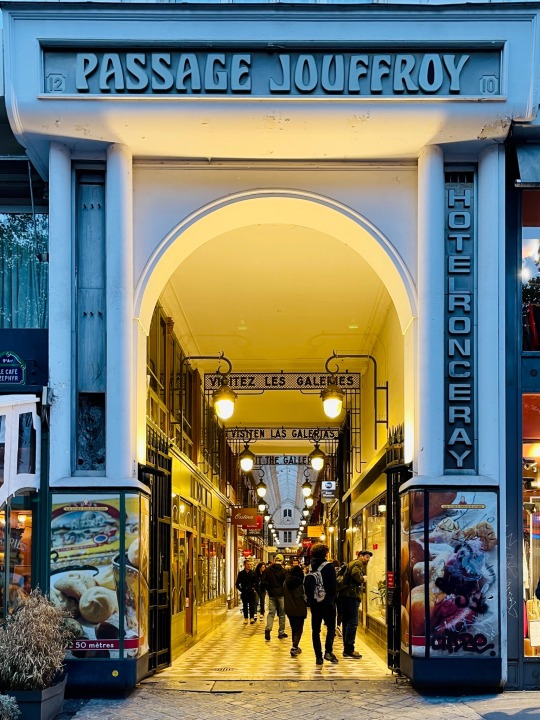
.
Wednesday Wanderings and Wonderings - The Passage Edition
Passage Jouffroy (9-12, boulevard Montmartre – 9, rue de la Grange Batelière, 75009 Paris)
-> First passage to be heated by the floor
Created in 1847 in the axis of the Passage des Panoramas, it is one of the most frequented passages. In 1882, Mr. Meyer, director of the newspaper "Le Gaulois", had the idea to join forces with Mr. Grévin, a famous caricaturist at the time, to create a gallery of wax figures. The Jouffroy passage is the first passage built entirely of iron and glass. Its metal structures bear witness to the evolution of techniques, cast iron columns support the floors and rise up to the glass roof. The passage was the first to be heated by the floor. Note the ogival skylight. The configuration of the site forced the architects to create an "L" shaped drop from a staircase that makes up for a slight incline. The stores of the passage were always of quality, cafés, milliners, tailors, hairdressers, lingerie, glove store… The oldest hotel in Paris, the Hotel Chopin, is located in the passage. It was entirely renovated in 1987 and, on this occasion, recovered its original paving. The Jouffroy passage has kept all its original charm and is always very visited. (Source)
*** But what is a passage? It is a private road open to the public, a shortcut between several roads, whether covered or not. As a pedestrian space, the passage can house both commerce and housing. Only the abundant decoration and the luxury of the stores differentiate a gallery from a passage. It’s the ancestor of today's shopping malls, the unique charm of Parisian covered passages will immediately transport you to the 19th century (Previous Posts)***
#CelineIsNotAnExpatAnymore#france life#paris#passages#CelineWandersAndWondersInParis#CelineAndPassagesInParis
2 notes
·
View notes
Text
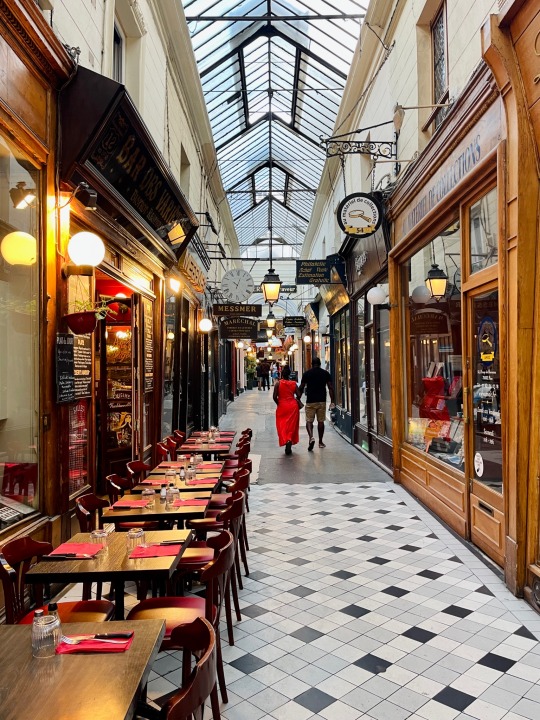



.
Wednesday Wanderings and Wonderings - The Passage Edition
Passage des Panoramas (11-13, boulevard Montmartre, 75002 Paris)
-> The oldest passage (1799) and site of testing for gas lighting (1816)
It's the oldest covered passage of Paris (1799) with decoration made of old signs and period lights which makes it one of the prettiest of the capital. Backyard of the Hôtel des ventes Drouot, it still attracts some collectors' stores.
In 1799, the American shipowner Thayer had two towers built on the Boulevard Montmartre in which he installed his panoramas (A panorama is a rotunda with lighting in which is installed a fresco painted in trompe l'oeil). In order to facilitate access from the Palais Royal to the Boulevard and to attract customers, he opened the Passage des Panoramas which would protect passers-by from rain and mud on the site of the former Hôtel de Montmorency. The success of the passage was immediate thanks to the enthusiasm of the Parisians for the panoramas, to its exceptional location on the boulevard, near the Bourse, and especially to the Théâtre des Variétés which was built against it in 1807. The rotundas of the boulevard Montmartre were demolished in 1831. But if the vogue of the panoramas died out, that of the passage continued. (source)
Also In 1816, gas lighting was tested in the passage.
*** But what is a passage? It is a private road open to the public, a shortcut between several roads, whether covered or not. As a pedestrian space, the passage can house both commerce and housing. Only the abundant decoration and the luxury of the stores differentiate a gallery from a passage. It’s the ancestor of today's shopping malls, the unique charm of Parisian covered passages will immediately transport you to the 19th century (Previous Posts)***
#CelineIsNotAnExpatAnymore#France life#Paris#passages#CelineWandersAndWondersInParis#CelineAndPassagesInParis
2 notes
·
View notes
Text
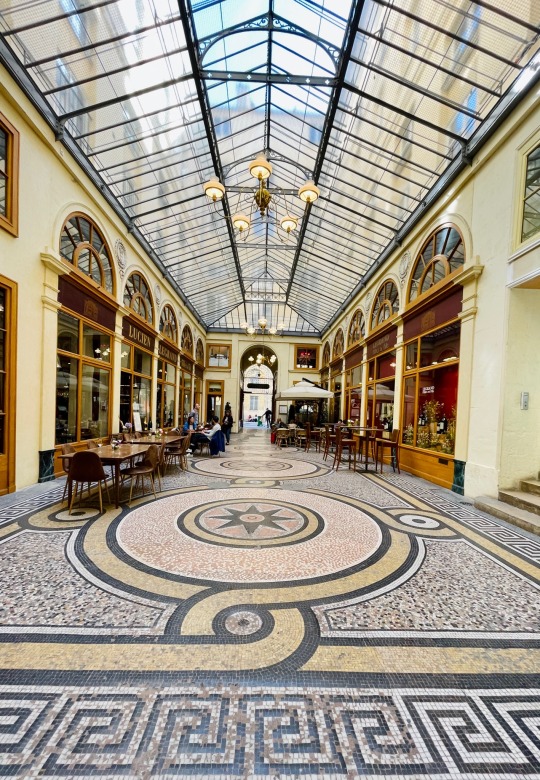



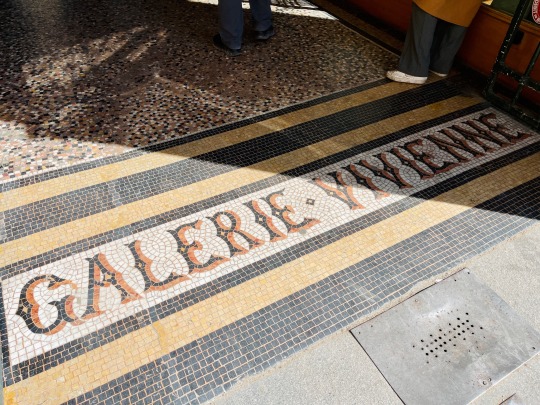
.
Wednesday Wanderings and Wonderings - The Passage Edition
Passage Galerie Vivienne
The passage that is not named a Passage but a Galerie. This passage is one of the most impressive ones. The mosaic floor is the work of Faccina. The large gallery of 42 m long is followed by a glass rotunda with a hemispherical glass dome, original, allowing a modulated ventilation. This galerie has 3 entrances (4, rue des Petits Champs - 5, rue de la Banque - 6, rue Vivienne)
Inaugurated in 1826, it attracted many visitors with its stores of tailor, boot maker, wine merchant, restaurateur, bookseller, confectioner, print merchant… From the Second Empire onwards, the gallery lost some of its appeal with the move of prestigious shops to the Madeleine and the Champs-Élysées. But since 1960, the gallery has become very active again. It presents fashion and decoration stores, haute couture shows are held there. Luxury shops are numerous.
*** But what is a passage? It is a private road open to the public, a shortcut between several roads, whether covered or not. As a pedestrian space, the passage can house both commerce and housing. Only the abundant decoration and the luxury of the stores differentiate a gallery from a passage. It’s the ancestor of today's shopping malls, the unique charm of Parisian covered passages will immediately transport you to the 19th century (Previous Posts)***
#CelineIsNotAnExpatAnymore#France life#Paris#CelineWandersAndWondersInParis#CelineAndPassagesInParis#passages
3 notes
·
View notes
Text


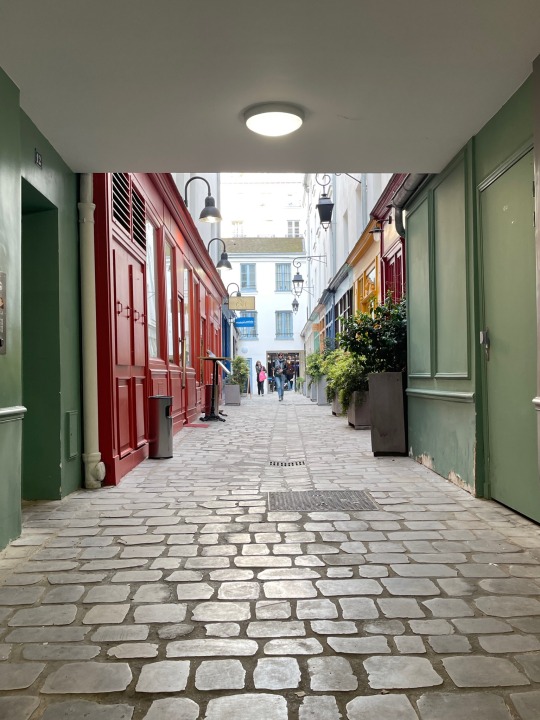
.
Wednesday Wanderings and Wonderings… Passage Edition
Starting a new series with the documentation of the many passages in Paris since quite a few are located near our place.
The series came upon because I often take the Passage Molière as a shortcut to get back home.
But what is a passage? It is a private road open to the public, a shortcut between several roads, whether covered or not. As a pedestrian space, the passage can house both commerce and housing. Only the abundant decoration and the luxury of the stores differentiate a gallery from a passage. It’s the ancestor of today's shopping malls, the unique charm of Parisian covered passages will immediately transport you to the 19th century.
So this is not the most beautiful or famous one but it’s dear to my heart because it’s close to our place. Plus I think it’s cute with a mix of covered and uncovered part and the cute little store and a nice little cafe.
#CelineIsNotAnExpatAnymore#France life#Paris#CelineWandersAndWondersInParis#CelineAndPassagesInParis
3 notes
·
View notes